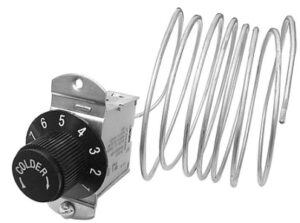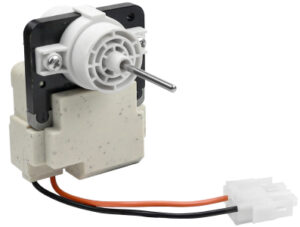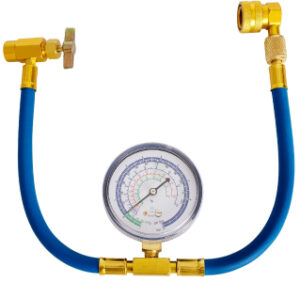Are you experiencing the frustration of a fridge that’s blowing warm air instead of keeping your food cold? It can be a worrisome and inconvenient problem to deal with, especially when you rely on your refrigerator to preserve your perishables. But fear not! In this beginner’s guide, we will explore the common reasons why your fridge might be blowing warm air and provide you with practical solutions to address the issue. Whether you’re a homeowner or a tenant responsible for appliance maintenance, this article will help you troubleshoot and prevent your refrigerator from blowing hot air.
Understanding the inner workings of your refrigerator is essential to maintaining its functionality. One of the key reasons for warm air circulation could be a malfunctioning compressor or condenser coils that need refrigerator repair. These components play a critical role in regulating the temperature inside your fridge. Dust and debris accumulation on the coils can hinder their performance, causing your fridge to struggle in maintaining the desired coolness.
Common Reasons Why Your Fridge Might Be Blowing Warm Air
Faulty Thermostat
One of the primary culprits when your refrigerator is blowing warm air is a faulty thermostat. The thermostat is responsible for regulating the temperature inside your fridge, and if it malfunctions, it may fail to signal the compressor to cool down. This can result in your fridge blowing warm air instead.
To diagnose a faulty thermostat, start by checking the temperature settings. Ensure that the thermostat is set to the appropriate cooling level. If it’s already set correctly, you may need to consider replacing the thermostat. Contact a professional appliance technician who can help you identify and resolve the issue.
Blocked Condenser Coils
Blocked condenser coils can also lead to a refrigerator blowing hot air. The condenser coils are located either at the back or underneath your fridge, and their primary function is to dissipate heat from the refrigerator’s interior. Over time, dust, dirt, and other debris can accumulate on these coils, inhibiting their ability to release heat effectively.
To address this issue, unplug your fridge and locate the condenser coils. Carefully clean them using a vacuum cleaner or a soft brush to remove any built-up debris. Regularly maintaining clean condenser coils can help prevent your refrigerator from blowing warm air and ensure optimal cooling performance.
Defective Fan Motor
A defective fan motor can also be the reason why your fridge is blowing warm air. The fan motor is responsible for circulating cool air from the freezer to the refrigerator compartment. If the motor malfunctions, it can disrupt the airflow, resulting in inadequate cooling.
To determine if the fan motor is the culprit, listen for any unusual noises coming from your refrigerator. If you notice a lack of airflow or strange sounds, it’s advisable to seek professional assistance. An appliance repair technician can inspect and replace the faulty fan motor if necessary.
Issues with the Compressor
The compressor is the heart of your refrigerator’s cooling system. It compresses the refrigerant, which then flows through the coils to cool down the interior of the fridge. If the compressor is malfunctioning or damaged, it can cause your fridge to blow warm air.
Identifying compressor issues requires professional expertise, as it involves intricate components and complex repairs. If you suspect a problem with the compressor, it’s best to contact a qualified technician. They can assess the situation, diagnose the problem, and provide the necessary repairs or replacements.
Insufficient Refrigerant
Refrigerant is a crucial component in maintaining the cooling process of your refrigerator. If there’s an insufficient amount of refrigerant or if it has leaked, your fridge may blow warm air. Low refrigerant levels can be caused by leaks, punctures, or even manufacturing defects.
Resolving refrigerant-related issues should be left to certified professionals, as it involves handling and refilling the refrigerant system. Contact an experienced technician who can identify the source of the leak, repair it, and recharge the refrigerant to ensure proper cooling in your fridge.
Preventive Measures to Avoid Your Fridge Blowing Warm Air
Now that we’ve discussed the common causes of a fridge blows hot air, let’s explore preventive measures you can take to avoid encountering this problem in the future. By following these simple tips, you can keep your refrigerator running smoothly and efficiently:
Regularly Clean the Condenser Coils
Regularly cleaning the condenser coils of your refrigerator is essential to maintain optimal cooling performance and prevent warm air from blowing. Over time, dust, dirt, and other debris can accumulate on the condenser coils, inhibiting their ability to release heat effectively. This buildup forces the compressor to work harder and can lead to inefficient cooling and warm air circulation.
To clean the condenser coils, follow these steps:
- Unplug your refrigerator: Before beginning any maintenance tasks, always unplug your fridge from the power source to ensure your safety.
- Locate the condenser coils: The condenser coils are typically located at the back of the refrigerator or underneath it. Refer to your refrigerator’s manual if you’re unsure about their exact location.
- Remove loose debris: Using a soft brush or a vacuum cleaner with a brush attachment, gently remove any loose debris, such as dust, pet hair, or food particles. Be thorough in cleaning all sides of the coils, including the fins.
- Deep cleaning: For a more thorough cleaning, you can use a coil cleaning brush or a condenser coil cleaning solution. Apply the cleaning solution as directed by the manufacturer and use the brush to remove any stubborn dirt or grime. Be careful not to bend or damage the coils during the cleaning process.
- Vacuuming: Once you’ve completed the deep cleaning, use a vacuum cleaner with a brush attachment to remove any remaining debris from the coils. Move the brush attachment along the coils, ensuring that all the accumulated dirt is effectively removed.
- Reconnect and plug in the refrigerator: After cleaning the condenser coils, reattach any components that were removed during the process and plug in your refrigerator. Make sure it is properly positioned and has adequate space for ventilation.
Check and Adjust the Thermostat Settings
The thermostat controls the operation of the cooling system, ensuring that the fridge maintains a consistent and optimal temperature for food preservation.
Here’s how you can effectively check and adjust the thermostat settings:
- Locate the thermostat: The thermostat is usually located inside the refrigerator compartment. Refer to your refrigerator’s manual if you’re unsure about its exact location.
- Check the current temperature setting: Look for the temperature control dial or buttons on the thermostat. The dial may have temperature markings ranging from cold to warm or may display specific temperature values. Take note of the current temperature setting.
- Verify the recommended temperature range: Consult your refrigerator’s manual or manufacturer’s instructions to find the recommended temperature range for proper food storage. Generally, the optimal temperature for a refrigerator is between 35°F (1.7°C) and 38°F (3.3°C).
- Adjust the thermostat if necessary: Compare the current temperature setting with the recommended range. If the setting is too high or too low, adjust it accordingly. Gradually make small changes to the temperature setting, allowing the refrigerator to stabilize for a few hours before assessing the impact. Avoid making drastic temperature adjustments, as sudden changes can affect the internal temperature and potentially cause warm air blowing.
- Avoid placing hot or warm food directly into the fridge: Placing hot or warm food directly into the refrigerator can temporarily raise the internal temperature, potentially leading to warm air blowing. Allow hot or warm food items to cool down to room temperature before placing them in the fridge. You can use a cooling rack or let the food sit uncovered for a while to facilitate faster cooling.
- Monitor and make further adjustments: After adjusting the thermostat settings, monitor the temperature inside the fridge for a few days. Use a refrigerator thermometer to accurately measure the temperature and ensure it consistently falls within the recommended range. If necessary, make further adjustments to the thermostat until you achieve the desired temperature and maintain it consistently.
Keep the Refrigerator Well-Ventilated
Proper ventilation is essential for ensuring efficient cooling and preventing warm air from blowing into your refrigerator.
Here are some important considerations:
- Avoid tight spaces and walls: When positioning your refrigerator, it’s crucial to avoid placing it in a tight space or directly against a wall. These cramped conditions restrict airflow and can hinder the proper functioning of the cooling system. Ideally, leave some space between the back of the refrigerator and the wall to allow air to circulate effectively.
- Provide adequate space: Ensure that your refrigerator has sufficient space on all sides for proper airflow. The manufacturer’s guidelines or the refrigerator’s manual often provide recommendations for the minimum clearance required around the fridge. Typically, leaving a few inches of space on each side and at the back is recommended. This allows for unrestricted airflow and helps the compressor and cooling system work optimally.
- Check for obstructions: Regularly check for any obstructions around the refrigerator that may impede airflow. Make sure there are no items, such as boxes, containers, or curtains, blocking the vents or hindering the air circulation. Keep the area around the refrigerator clean and free from clutter to maintain adequate ventilation.
- Clean the ventilation grilles: The refrigerator’s ventilation grilles, located either at the front or on the bottom, play a crucial role in allowing air to flow in and out of the cooling system. Over time, these grilles can become clogged with dust, dirt, and debris, restricting airflow. Periodically clean the grilles using a vacuum cleaner or a soft brush to remove any buildup and ensure proper ventilation.
- Consider ambient temperature: The ambient temperature in the room where your refrigerator is located can also impact its cooling efficiency. Avoid placing the fridge near heat sources such as ovens, dishwashers, or direct sunlight. Excessive heat can make the compressor work harder and potentially result in warm air blowing. Maintaining a cool environment around the refrigerator will help it operate more efficiently.
Avoid Overloading the Fridge
Avoiding overloading your refrigerator is crucial to maintain proper airflow, ensure efficient cooling, and prevent warm air from blowing.
Here are some key tips to keep in mind:
- Know the maximum capacity: Familiarize yourself with the maximum capacity recommended by the refrigerator manufacturer. This information is typically provided in the user manual or on a label inside the fridge. Understanding the maximum capacity will help you gauge how much food and items your refrigerator can accommodate without compromising its cooling performance.
- Distribute items evenly: When arranging items inside your fridge, distribute them evenly to allow for proper airflow. Avoid overcrowding specific shelves or compartments, as this can block the circulation of cold air and lead to uneven cooling. Distributing items evenly throughout the fridge ensures that cold air can reach all areas and helps maintain a consistent temperature.
- Leave room for air circulation: It’s essential to leave sufficient space for air circulation inside the refrigerator. Blocking the vents or overcrowding the shelves can impede the flow of cold air, leading to inadequate cooling and potential warm air blowing. Allow a gap between items and the walls of the refrigerator to enable proper airflow. This space also helps maintain a more stable temperature throughout the fridge.
- Consider organizing with storage solutions: Utilize storage solutions such as clear bins, stackable containers, and fridge organizers to maximize space and keep items organized. These solutions can help prevent items from spilling or taking up excessive space, allowing for better airflow and efficient cooling. Group similar items together and label containers for easy identification, making it easier to locate specific items without rummaging through the fridge.
- Regularly declutter and remove expired items: Regularly go through your refrigerator and remove any expired or spoiled items. This decluttering process not only helps create more space but also ensures that you’re not overloading the fridge with unnecessary items. Removing expired food prevents odors and helps maintain a clean and fresh-smelling refrigerator.
Schedule Regular Maintenance Checks
Scheduling regular maintenance checks with a professional appliance technician is a proactive step to ensure your refrigerator remains in optimal condition and to prevent the occurrence of warm air blowing.
Here’s why regular maintenance is crucial and how it can help:
- Professional inspection: A qualified appliance technician has the expertise and knowledge to thoroughly inspect your refrigerator. During a maintenance check, they will examine various components, including the thermostat, condenser coils, fan motor, compressor, and refrigerant levels. This comprehensive inspection can identify any underlying issues or potential problems that may lead to warm air blowing in the future.
- Early issue detection: Regular maintenance checks allow technicians to detect problems early on, even before they become noticeable or cause significant damage. By identifying issues in their early stages, repairs can be performed promptly, preventing them from escalating into more significant and costly problems down the line. Early detection and intervention help maintain the proper functioning of your refrigerator and reduce the risk of warm air blowing.
- Cleaning and servicing: During a maintenance visit, the technician will clean and service various parts of the refrigerator. This includes cleaning the condenser coils, removing any accumulated dust and debris, which can obstruct proper heat dissipation and cooling efficiency. They may also lubricate moving parts, check electrical connections, and ensure the overall functioning of the refrigerator is optimized. These routine maintenance tasks help prevent issues that can lead to warm air blowing and ensure your fridge operates at peak performance.
- Repairs and replacements: If any components are found to be malfunctioning or worn out, the technician can perform the necessary repairs or replacements. Faulty parts such as a malfunctioning thermostat, fan motor, or compressor can contribute to warm air blowing. By addressing these issues promptly, the technician restores the proper functioning of your refrigerator and prevents the inconvenience of warm air circulation.
- Professional guidance: During a maintenance check, you have the opportunity to discuss any concerns or questions you may have about your refrigerator with the technician. They can provide valuable advice on proper usage, temperature settings, organization, and maintenance practices that can help prevent warm air blowing and optimize the performance of your fridge.
Dealing with a fridge that’s blowing warm air can be frustrating, but with the right knowledge and preventive measures, you can troubleshoot and address the problem effectively.
So, the next time you find your fridge blowing warm air, don’t panic. Armed with this guide, you have the knowledge and tools to diagnose and resolve the issue promptly. Enjoy the benefits of a properly functioning refrigerator and peace of mind knowing that your perishables will stay cool and preserved as intended.